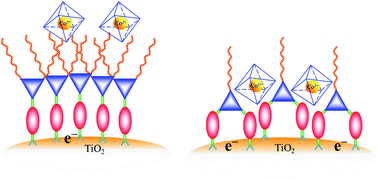The combination of some non-iodine one-electron outer-sphere redox shuttles with high-absorption-coefficient organic D–π–A dyes has very recently brought forth a new opportunity towards efficiency enhancement of dye-sensitized solar cells (DSCs). Thereby a comprehensive understanding on the structure–property relationship of metal-free organic photosensitizers will play a pivotal role in further development of high-efficiency devices iodine-free. Herein, we scrutinize some general influences of the cyanoacrylic-acid-anchoring-group number of organic dyes upon the optoelectronic features of mesoscopic titania solar cells based on the tris(1,10-phenanthroline)cobalt(II/III) redox shuttle, by employing three pairs of uniped and biped dyes with thiophene, 3,4-ethylenedioxythiophene and 4,4-dihexyl-4H-cyclopenta[2,1-b:3,4-b′]dithiophene as the π-conjugated spacers. It is found that regardless of the spacer selection, a biped dye confers an improved light absorption coefficient of a stained titania film in comparison with its uniped analogue, which is highly desirable for cells with a one-electron outer-sphere redox shuttle, because in this type of cells a very thin titania film is always needed to satisfy the mass transport and electron collection requirements. However, our electrical impedance analyses have revealed that the alteration from a uniped chromophore to its biped congener evokes not only a downward displacement of the titania conduction band edge but also an acceleration of interfacial charge recombination of the titania electrons with cobalt(III) ions, leading to an attenuated open-circuit photovoltage, highlighting the future necessity to design a sterically bulky organic dye featuring superior light-harvesting capacity.

You have access to this article
 Please wait while we load your content...
Something went wrong. Try again?
Please wait while we load your content...
Something went wrong. Try again?


 Please wait while we load your content...
Please wait while we load your content...